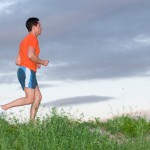 We all know that exercise is good for us and generally why (helps us lose and maintain weight, keep our heart healthy, beats stress and feels good). But what happens inside the body that makes exercise so healthy?
We all know that exercise is good for us and generally why (helps us lose and maintain weight, keep our heart healthy, beats stress and feels good). But what happens inside the body that makes exercise so healthy?
Why do I have to work hard enough to breathe heavy in order to lose weight?
Respiration (breathing) obtains oxygen which the body uses to release energy from the food you eat and moves gaseous wastes (carbon dioxide) from the body. Exercise that feels like an effort helps you increase the amount of oxygen that your lungs can hold and use (called VO2max.) The more oxygen you get in, the more efficiently you will use the energy (calories) in the food you eat and release energy in the food you have stored (in your muscles and fat.)
What is the right amount of time to work out in order to lose weight?
The answer depends on how hard you are willing and able to work. The latest guidelines suggest that people exercise for 150 minutes (2.5 hours) per week at moderate intensity(able to talk but not converse.) There are many ways to accumulate 150 minutes of exercise each week –all 150 minutes at once on one day (not recommended for most), 2 days of 60 minutes and 1 of 30 minutes, 5 days of 30 minutes each, etc. However, for weight loss you need to work a little harder and/or longer. You must do enough exercise, not only to burn calories, but to burn off the excess calories stored in fat. What that means is that you must perform cardiovascular exercise where you are breathing hard (but can still say a phrase or two) a minimum of 5 times a week for a minimum of 30 minutes each time. If you are just starting out or have any medical issues, fitness professionals recommend obtaining a doctor’s clearance before beginning. Also, consider opting for exercising for 45 to 60 minutes 5 days a week at a lower intensity. Choose activities that you enjoy and varying the exercise from time to time, such as walking one day and maybe biking another. Keep in mind, that whatever you choose, different activities will burn different amounts of calories in the same time frame.
How does my body actually lose weight?
It is easy and correct to say that weight loss is the result of eating fewer calories than you burn, however for most of us trying to lose weight, it does not feel that simple. Be clear if you want to lose weight or lose a size in clothing. It is possible to lose a size and not lose any weight at all, or even gain some weight. Muscle takes up less space in the body for the same weight than fat does. The body actually burns only calories when you exercise. Where it gets those calories from depends how much you eat. If you ate a lot of calories, then it will burn the calories contained in blood glucose, and glycogen (stored glucose in the muscles.) Our bodies are efficient and will get energy in the easiest way possible using the metabolic path with the least amount of steps to turn calories into energy first. After approximately 20 minutes of exercise, the body will start to burn calories stored in fat. However, if you overeat, those fat cells will not shrink when the calories stored in them are burned. They will store the new excess calories. That is why you must control the amount of calories you consume. Think about portion control, and normal portions are generally 3 to 4 times smaller than seen on an American plate. Use small plates!
By Mary Miriani; BA Exercise Science; ACSM Health/Fitness Specialist. Contact her via email, mary@miriani.com.
 Subscribe
Subscribe